|
A Tale of a Magnetite Black Sand Harvesting Field Trip in the Southwestern USA in June 2007 Yielding over 1,200 Pounds of High-Quality Magnetite Sand ver. 1.0.9 last revision date: 06/18/2019
Introduction
Further
Notes and
Q/A on
Constructing Your Own MEOW DevicesMuch as I have already mentioned on the Magnetite Sources page on this site, it is extremely rare to be able to wrangle permission from owners of operating magnetite mines in the USA to visit their sites to purchase small amounts of magnetite, as they are invariably set up only to be able to handle large bulk sales on the order of 20 or more tons per truckload or railcar load and where their bulk customers provide the trucks (or railcars) for transportation; these mines are never set up to handle small orders such as a 50 pound bag or sack or bucket, or even a ton or two of sand. Worse, due to OSHA rules and insurance regulations, it can be a major nightmare for the mine operators to even allow a visitor onsite at the mine. Further, these mines never have any ability to package their sand in bags, sacks or buckets, and so, in the rare cases where you may be able to wrangle permission to purchase small quantities of sand -- perhaps on the order of 50 pounds to a half-ton -- you will need to be able to show up with your own sacks or buckets for transport, as well as a vehicle capable of carrying the containers once loaded. And you will need to be able to demonstrate that you can abide by safety rules and requirements while onsite. And, it is my personal experience, as well as that of other researchers whom I know, that such permission is granted only very rarely. In fact, of the operating magnetite mines in the USA of which I am personally aware and where I have been in contact with the owners/operators, each has strongly requested that I never divulge the location of their mine nor their contact information to anyone, and, each of the owners/operators has made clear that our continued goodwill relationship is based upon the condition that I never reveal the mine location nor contact information for the operators, as they all feel that requests to purchase small quantities (i.e., anything smaller than the 20+ ton truckloads sold to established commercial / industrial customers who provide their own trucks for transport) would be extremely distracting and annoying; as one mine owner said to me during a conversation in late June 2007 "that would not work at all for me; I would hang up the phone on people making such a request. We are not set up for that." In light of these strong and repeated requests from mine owners, please do not contact me asking for the location of any operating magnetite mines nor for contact information for the owners or operators of such mines. Such requests will not be met in a friendly or civil manner. A Brief Photo Narrative of My November 2007 Field Trip to UT and CO: Exotic Energy Research and Ormus Ore Research For a brief photo narrative and commentary on my November 2007 field trip to UT and CO in the Rocky Mountains to conduct exotic energy research, meet with fellow exotic energy researchers, and to conduct research on sources of exotic ormus-rich minerals and ores, you may wish to review the page on my exotic Energies site entitled A Photo Essay and Overview of My November 2007 Field Trip to UT and CO: Researching Aetheric Energy and Exotic Energy Technologies A Tale of a Magnetite Black Sand Harvesting Field Trip in the Southwestern USA A Magnetite Sand Harvesting Field Trip to a Magnetite Mine in June 2007 I have, in a couple of instances, been able to procure permission from the owners of small magnetite mines to briefly visit their facilities and to collect a modest quantity (ranging from 200 pounds to 1,400 pounds at one time) of magnetite sand (for use in my extensive R&D work in my shop and lab) in return for a modest fee, so long as I provided all containers for loading and packing the sand, along with a sturdy vehicle capable of navigating the mine site and, most importantly, capable of transporting the loaded containers. Of course, since these mines were all located many hundreds or thousands of miles from my home and laboratory, it also fell upon me, once I left the mine site with my now-loaded buckets of magnetite sand, to handle all details of shipping the magnetite sand back to my home office and lab. To illustrate some of the various aspects and challenges of such an endeavor, I have created this current webpage article, which tells the tale of such a visit which I made, along with a friend who was acting as my research assistant, to a small magnetite mine in the Southwestern US in June 2007; the tale includes a glimpse of the logistics of harvesting and transporting 1,250 pounds of magnetite sand from the mine site in short order, and then the logistics of subsequently packaging the sand for shipping back to my home office and lab on the East Coast, over 2,300 miles away. And, since a great number of New Agers and fringe-science researchers had told me with utter seriousness in the months before I left for the Southwest that the deserts of Nevada, Arizona and New Mexico are populated with colonies of hostile alien reptoi7d reptilia9ns who are protected by renegade government agents callled the me5n in Black, we also made it a point to try to meet with emissaries of the reptoi7d reptilia9ns during the field trip; you will find a briefing on this matter as well in the tale below. A reminder: in light of the many issues addressed above, please do not contact me asking for the location of any operating magnetite mines nor for contact information for the owners or operators of such mines. Such unwelcome inquiries will not be met in a friendly or civil manner. First, a Meeting and Dinner with John Milewski in Arizona A portion of my trip to the Southwest in mid-June involved a stay in Tempe, Arizona, and it turned out that Dr. John Milewski and his wife (who live in Albuquerque, NM) would be on a road trip in the Tempe area at the time of my visit there, and so they decided to stay overnight at the hotel at which I was staying; this would give us a chance to finally meet in person and discuss a number of common interests, including MEOW technologies. And so, on a bright 113F Wednesday afternoon in mid-June, there was a knock on my hotel room door and there stood John Milewski; I met his wife minutes later as well! John and I got to spend several hours together over the next day, and among other things, he examined my new portable pod MEOW devices (the dunking sceptres and the egg) with interest. That evening, my friend Loui, who is a yoga teacher in the area, and I had dinner at a nearby restaurant with John and his wife, and John treated -- thank you, John! One or two pics follow...  In the image above, John and I are shown sitting in a restaurant in Tempe, AZ in mid-June 2007, after having had dinner together. Also present were John's wife and my friend Loui.  Stocking Up on Supplies for Collecting, Transporting, Packing and Shipping the Sand One of my tasks on the trip was to visit the earlier-mentioned magnetite mine and harvest some magnetite sand, which I then planned to package in my hotel room and ship back to my lab and home office on the East Coast. My good friend Moti, who is a Los Angeles-based artist and mystic (and who is thus very immersed in the spiritual realm and also interested in ormus-like nutritionals) flew in to join me for this portion of the trip; she had volunteered to act as my research associate on our various collecting trips and visits with local researchers. A small pic of Moti follows:  The image above is a head shot of my friend and colleague Moti. After I checked into a hotel located a few hours away from the mine, one of the first things that I did after getting settled into my room was to visit the local post office and pick up 50 empty Priority Mail boxes of suitable size. Then I visited a supermarket, Staples office supply warehouse and a Home Depot contracting warehouse, where I purchased 600 one-gallon heavy duty ziplock freezer bags, ten rolls of heavy duty package sealing tape, two packing tape dispensers, scoops, sheets of cardboard to use as inner reinforcement in the shipping boxes, indelible markers, rigid foam sheet (again for packing and reinforcing boxes), tarps, and twenty-five 5 gallon buckets and lids, along with a varied assortment of hardware needed to handle the collection and packaging tasks.  The Visit to the Mine to Harvest Sand We arrived at the mine in mid-morning, and, after spending an hour or two chatting with the owners in their offices, we grabbed hardhats and shovels and moved our rental car to a waiting pile of magnetite sand. I had deliberately rented a very tough mid-sized car that was conservatively rated for carrying at least a half-ton of passengers plus load, and while we sure put the car to a test on this venture, it handled the load fine, without a complaint. All in all, we spent about 40 minutes shoveling about 80 pounds of magnetite sand into each bucket and sealing the buckets before placing them on a tarp in the rental car. Here are some photos which show parts of the process:  The image above shows our rental car as we loaded it from the rear hatch with buckets, each filled with about 80 pounds of magnetite sand.  And, above, a shot of some of
the as-yet-empty buckets awaiting filling and loading.
 Above is a shot of Moti shoveling magnetite sand to fill a bucket. Notice the color and fine grain size of the sand. The sloping pieces of equipment in the background are magnetic separators; Moti is harvesting sand from the pile deposited at the output of a separator.  And here Moti is dumping a shovelful of sand into a bucket. We filled each bucket with about 75 to 85 pounds of sand, and then sealed them and packed them into the car.  Above
is a shot of the bucket loader dumping raw alluvial desert sand into
the
intake hopper of a magnetic separator.
 The image above is a shot showing a wider view of the magnetic separator. Note the magnetite sand dribbling from the output chute.  The photo above shows Moti as she rode in the cab of the Caterpillar bucket loader as it picked up about eight tons of alluvial desert sand and dumped it into the intake hopper of the magnetic separator.  The image above is a shot taken by Moti from the cab of the Cat bucket loader as it carries its load of desert sand to the intake hopper of the multi-stage magnetic separator. Our task of filling buckets and loading them into the rental car took about 40 minutes under the 114F desert sun. By the time we were done, we had filled and sealed 16 buckets and packed them into the car; each was loaded with 75 to 84 pounds of magnetite sand. Our total harvest was a bit over 1,200 pounds of very high-quality sand. Despite the rather considerable load of 1,200+ pounds of magnetite sand plus Moti and myself, the rental car handled flawlessly, even on the rural dirt roads. A Glimpse at the Sand I call this sand type EFLMG, and it is typical of magnetite sand from many alluvial desert deposits in that it contains an excellent grade of magnetite and is very high in rare earths and also contains very good levels of other elements and elemental forms of interest for use in MEOW technology. The sand is dark brownish in color, with perhaps a slight reddish tint, and particle size falls primarily in the range from 20 mesh to 180 mesh, with much of the sand in the range of 20 mesh to 100 mesh. As is typical of most magnetite sands as they leave the mine, the sand still contains a small amount of non-magnetite components. While the average batch of magnetite sand coming from this mine after it exits the magnetic screening separator is usually about 75% to 82% magnetite, we were able to harvest our magnetite from a higher-purity pile where the sand also exhibited a smaller particle size than that of the sand normally exiting the separators. My subsequent analysis of this type EFLMG sand after returning to my lab on the East Coast showed that the sand was, on average, about 90% pure by weight, i.e., where about 90% of the mass of the sand consisted of high-quality grains of magnetite, titanomagnetite and (to a lesser extent due to its weaker magnetic properties) ilmenite, and the remaining 10% of particles by weight consisted of non-magnetic material which was reddish-brown in color and with a very fine particle size. For use in MEOW kettles and other MEOW devices, I ultimately chose to leave the so-called "impurities", that is, the non-magnetic particulate components, in the sand, as I discovered that in this case it lent important ormus-effect properties to the magnetite sand. In fact, this serves as good reminder that in a number of cases, the non-magnetic particulartes which may comprise from 10% to 60% of "raw" magentite sand by weight will sometimes prove to exhibit powerful desirable ormus field effects, and thus it will de desirable to leave a percentage (and sometimes all) of such "impurities" in place in the sand for use in MEOW devices. In some other cases, the non-magnetic components will not exhibit desirable ormus field effet properties, and in those cases, it is better to remove them using magnetic separation methods. A few photos follow. 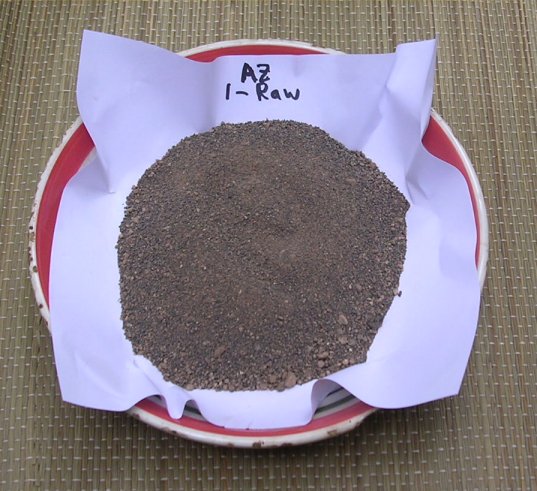 The image above shows the sand in its raw form as we harvested it at the mine, with no additional screening steps to sort/refine by particle size or for magnetic properties. Note the rather wide range of particle size, and the brownish color. 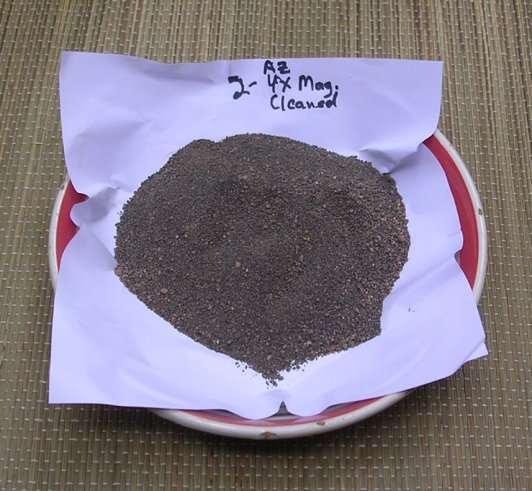 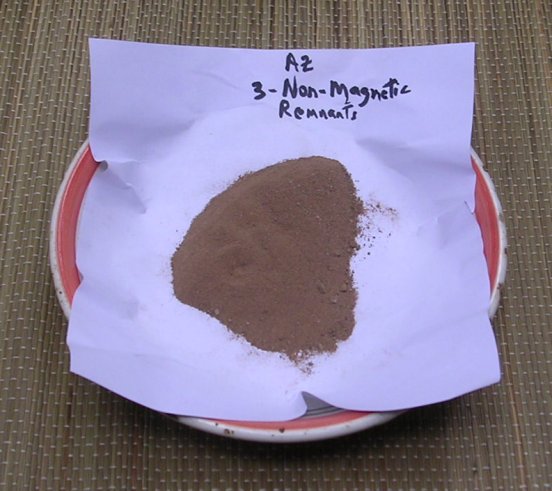 As mentioned earlier, my studies showed that the sand contained about 9% non-magnetite components by weight. I was then faced with the choice of using the sand which we had collected in its raw form for my work with MEOW kettles and related technologies, or using one ore more steps of magnetic refining to increase its "purity". Given the nature of the MEOW field-effect phenomena and what we know of it, and guided largely by intuition, I chose to use the type EFLMG sand in its original raw state -- as harvested at the mine from the output of the magnetic separators -- for my MEOW technology research. My sense is that the non-magnetic material, which, as we have seen, comprises about 9% of the mass of the sand, contains very useful levels of rare earth elements, transition elements and ormus forms of elements, and that it was simply not worth the effort to use further stages of magnetic separation to remove some of the non-magnetic components. Likewise, while I could have chosen to subject the sand to at least one stage of mechanical screening, perhaps using a 20 mesh sieve (aka classifier) to remove particles larger than 20 mesh in size, again, due to the overall high quality of the sand, I chose not to bother with using any stages of mechanical screening. While there were some particles present which were larger than 20 mesh in size, they were never, on average, larger than 0.15 inch, and comprised only a very small percentage of the total mass of sand. The bottom line is that I ultimately chose to employ the sand exactly as it had been harvested at the mine, with no additional stages of mechanical screening or magnetic separation. Analyzing and Processing the Batch Sand Destined for Delivery to the Reptilia9ns note: due to a request received from the MIB, any and all occurrences of the terms "reptoi7d", "reptilia9n" or "me5n in Black" must appear in slightly altered form, with a numeric character inserted in the term; we were told by the MIB that this is necessary to prevent certain "interested parties" from finding these pages using an Internet search engine. Much as is mentioned in the section -- entitled And now, for the reptoi7d reptilia9ns -- about the reptoi7d reptilia9ns below, a small part of our sand harvest, about two hundred pounds, had been promised -- in light of a rather forceful request received from the Me5n in Black the night before we departed for the mine -- to a colony of alien reptoi7d reptilia9ns living in the desert on the AZ/NM border; that batch of sand required further processing before it could be delivered to the reptilia9ns, and we had been asked to perform the necessary -- if bizarre -- testing and processing prior to delivery of the material to the reptoi7d reptilia9ns. Thus, after harvesting the sand, our next stop was a small commercial contractual laboratory and materials treatment facilitiy located in an industrial park, where -- for a fee of four thousand dollars (paid in large part, thankfully, by the me5n in Black) -- we had rented lab space for six hours to allow us to analyze and then process the two hundred pounds of sand in an exotic and proprietary six-stage process. The lab was located about a three-hour drive from the mine site, and we arrived at the lab in early afternoon. The photos below show a glimpse of some of the proprietary steps of matrerial processing, including a shot of Moti in her protective suit going through the airlock of the materials treatment room.  The image above seems to show Moti at the control panel of a sophisticated analytic device while performing preliminary analysis of the batch of black sand destined for delivery to the reptoi7d reptilia9ns..  The picture above is a shot of Moti in her radiation protective suit for the third of six stages of material treatment to which the magnetite was subjected. The picture was taken while she was standing in the UV sterilization flash-treatment chamber in an airlock, and thus the background appears largely all-white. 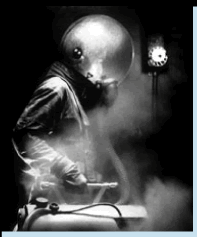 And, the image above shows a suited worker (we think it is Moti, but are not sure) shuttling a load of the sand destined for delivery to the reptoi7d reptilia9ns between two of the material treatment rooms via yet another interconnecting airlock. Once back at our hotel, we lugged the sixteen buckets of sand into the room and stacked them in preparation for the next steps, which involved bagging the sand and packing it carefully into USPS Priority Mail boxes for subsequent shipping.  The image above shows a few of the buckets stacked in a room in our hotel suite, as we slowly started the process of packing boxes for shipping. We then started the process of transferring the sand from the buckets into 15 pound triple-layer one gallon heavy-duty ziplock freezer bags, and we also started to wrestle with the final logistics of packing and shipping nearly 50 reinforced boxes of sand, each weighing between 30 and 33 pounds.  Two bags each were then placed into Priority Mail boxes, and the boxes were reinforced with battens made of corrugated cardboard and rigid foam slabs and then sealed. We also packed for shipping back to my lab an additional 200 pounds of another type of exotic magnetite sand and 50 pounds of red garnet sand both of which we had acquired elsewhere (this is referenced briefly in the section below). Due to the fact that the filled boxes weighed from 30 to 33 pounds, great care was devoted to packing and reinforcing each box to ensure that it would withstand the rigors of shipping, and we used not only heavy-duty packing tape for this process but also fiberglass strapping tape and cardboard and rigid foam batting/reinforcement. We used over 24 pounds of corrugated cardboard alone in reinforcing the boxes for shipping, plus considerable amounts of rigid foam sheet. A photo of some of the packed boxes appears below.  The image above shows one of three piles of packed, sealed and addressed shipping boxes lining the walls of our hotel room. Bright and early one morning near the end of our 9-day field trip, we carried 45 packed, sealed and addressed boxes -- each weighing about 32 pounds -- from our hotel room to the rental car, and then delivered them to a nearby post office for shipping. The process of loading the car, unloading the sand at the post office, and then processing and paying for shipping of all 45 packages took about 2.5 hours. Most of the packages were sent to my home office and lab on the East Coast, a few to Moti's studio in Los Angeles, and a few to some colleagues who had invested funds to help to support our field trip. Our near-obsessive packaging precautions paid off, and ultimately, all 45 packages arrived at their destinations without mishap. A Visit to a Mineral/Ore Warehouse and Museum and Related Field Excursions At one point during our 9-day field trip, Moti and I chartered a helicopter for a brief excursion to allow us to take a look at the alluvial desert terrain from above, largely to allow us to learn more about the local geology.  The image above shows Moti and I standing in front of the Bell helicopter. The pilot is seated in the craft in the right-hand seat; he is barely visible through the tinted windscreen behind us. We also reserved one day to make a visit to a city in south-central Arizona, where, among other things, we visited a mineral/ore warehouse where a colleague had arranged for me to pick up 200 pounds of another exotic magnetite sand. Moti and I also managed to find (thanks to my friend Loui and her great affinity for gems and crystals of all kinds) and purchase a 50 pound bag of red garnet sand; Loui also purchased some bags of garnet for her own use. The warehouse is run by an engaging man with a mystical bent named Jim, who has had a lifelong passion of studying, admiring and collecting rocks, gems and ores, and the 5-acre grounds of his home and commercial warehouse facility are filled with thousands of samples of exotic rocks, gems, and ores, forming a veritable shrine to the local alluvial desert geology. As I mentioned before, Jim is also a mystic, and he particularly has an affinity for images and statues of the Divine Mother with a baby child, and, since Jim is a Roman Catholic, the images of Mother and Child which he encounters are often reminiscent of the Christian concept of the Blessed Mother Mary and her child. Jim also has on his property a large custom-crafted stone religious statue -- which he feels must weigh at least 6 tons -- of what he calls Our Lady of Life; a sculptor simply showed up at his home one day - exactly as prophesized to Jim by Holy Spirit a week earlier -- and offered to create the massive statue for him. Jim gave me a small hardcopy photo of the statue and I have, with his permission, scanned it so that I could upload it to this page; it appears below. 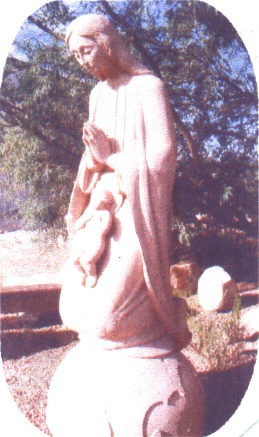 The image above is a photo of the massive statue of Our Lady of Life which sits on Jim's property; the statue was crafted for Jim by a sculptor who showed up at his door one day, exactly as had been promised to Jim by Holy Spirit. The image above has been scanned from a small photograph which Jim gave me. Unfortunately, we were so fascinated by Jim's museum-quality collection of rocks, ores and gems that we totally forgot to take photos of the massive collection, much of which is located outdoors. We will try to get some photos on our next visit to Jim and his warehouse. And now, for the Reptoi7d Reptilia9ns note: due to a request received from the MIB, any and all occurrences of the terms "reptoi7d", "reptilia9n" or "me5n in Black" must appear in slightly altered form, with a numeric character inserted in the term; we were told by the MIB that this is necessary to prevent certain "interested parties" from finding these pages using an Internet search engine. Much as I related above, since a great number of New Agers, fringe-science and alternative health researchers had told me with utter seriousness and sincerity, in the months before I left for the Southwest, that the deserts of Nevada, Arizona and New Mexico are populated by colonies of alien reptoi7d reptilia9ns who are "protected" by renegade government agents known as the Me5n in Black (aka MIB), Moti and I made it a point to try to meet with emissaries of the reptoi7d reptilia9ns during our field trip. Our efforts to find them were totally unsuccessful, and rather, the reptoi7d reptilia9ns, accompanied by three Me5n in Black, eventually contacted us, knocking on our hotel room door at 2 AM the morning before we were to visit the magnetite mine. We are not allowed by the MIB to disclose much of what we discussed, nor to discuss the information which the aliens disclosed about the abandoned ancient Egyptian-style city sitting underground about 800 feet beneath the surface of the Arizona desert, but the Me5n in Black and the aliens did strongly request that we harvest two hundred pounds of magneite sand specifcially for them; they also explained to us that us that this batch of magnetite sand would need to be subjected to some very exotic physical material treatments at a "special" laboratory (located two hundred miles away) before we delivered it to them. By the way, here are two quick photos of the reptoi7ds (we had tried to take photos of the me5n in Black as well, but those images failed to record properly on our digital cameras): 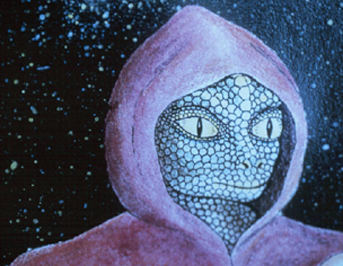 This photo above was shot at night in the desert near our hotel, about a half hour after the reptoi7d reptilia9ns and their Me5n in Black "handlers" first knocked on the door of our room at 2 AM.  The image above was shot in our hotel room, minutes after we had met the first of the reptoi7d reptilia9n emissaries. That's all folks! Enjoy! --Vinny A Brief Photo Narrative of My November 2007 Field Trip to UT and CO: Exotic Energy Research and Ormus Ore Research For a brief photo narrative and commentary on my November 2007 field trip to UT and CO in the Rocky Mountains to conduct exotic energy research, meet with fellow exotic energy researchers, and to conduct research on sources of exotic ormus-rich minerals and ores, you may wish to review the page on my exotic Energies site entitled A Photo Essay and Overview of My November 2007 Field Trip to UT and CO: Researching Aetheric Energy and Exotic Energy Technologies note: due to a request received from the MIB, any and all occurrences of the terms "reptoi7d", "reptilia9n" or "Me5n in Black" must appear in slightly altered form, with a numeric character inserted in the term; we were told by the MIB that this is necessary to prevent certain "interested parties" from finding these pages using an Internet search engine. A Response to Repeated Inquiries Asking Me if I Sell Magnetite Black Sand in Small Quantities I receive a number of inquires from folks in the worlds of MEOW devices, ormus and alchemy if I am willing and able to offer magnetite sand for sale. My answer is always as follows: With the sole exception of limited-time and conditional 24-hour offers made perhaps once or twice per year where I may offer limited amounts (perhaps two 30 pound boxes at most per person) of field-harvested magnetite black sand via a "community-supported-magnetite-sand-harvesting" (aka CSMSH) arrangement to a few friends and colleagues to help to finance one of my upcoming magnetite-harvesting field trips, I never offer magnetite black sand for sale in quantities below 600 pound batch size. Incidentally, above and beyond the small quantities distributed via the aforementioned and rare CSMSH offerings, any and all of the various batches of magnetite sands which I collect during my field trips is used solely to fuel my own research and development projects. However, for those researchers and experimenters who need bulk quantities of 600 pounds or more (and up to 600 tons) at one time of magnetite sand for use in MEOW devices and similar technologies, and who are willing and able to pay for the sand as well as the sizeable shipping and handling charges, I am able to offer magnetite sand in such bulk quantities on a prepaid basis, for delivery anywhere within continental mainland USA; the sand is available in loose bulk form via truck, or packaged in discrete 50 pound bags or discrete 30 pound boxes. Product pricing is very reasonable. Again, as noted above, I can offer for sale only bulk quantities of 600 pounds or more of magnetite sand; please do not contact me asking me to sell smaller quantities. If you need quantities smaller than 600 pounds, feel free to harvest your own sand using any of the methods described on the Magnetite Sources page on this website. Please see the FAQ page elsewhere on this site for further notes and questions and answers regarding constructing your own devices using cardboard and hot glue. Supplemental Mixture for the Magnetite Sand If you wish to read more information on the supplemental amendment mixture which I have developed which seems to potentize the ormus-creation effects of the magnetite black sand, please visit the main page of this website or the Prototype Products Catalog page. Requests for Bottles of Treated Water and for PoP Prototype Devices Assembled Using Sturdy Plastic Shells If you are looking for MEOW treated water or for pre-assembled devices and shells for devices (where you procure magnetite from a source of your choice and fill the device with magnetite after receiving the shell), please see the Prototype Products Catalog page on this website. Disclaimer Any products, technologies or devices mentioned on this page are experimental prototypes only, produced for the sole purposes of research and Proof of Principle (PoP) evaluation by professional or individual researchers or experimenters. The reader understands that the author is not engaged in rendering health or medical advice or services. The site owner and authors provide this information, and the reader accepts it, with the understanding that people act on it at their own risk and with full knowledge that they should consult with licensed primary care medical professionals for any medical assistance they may need. The author(s) of the material presented on this site are neither medical nor nutritional professionals. If you wish to learn more about my work and/or about my consulting services, please feel free to visit my main website at www.vinnypinto.us |